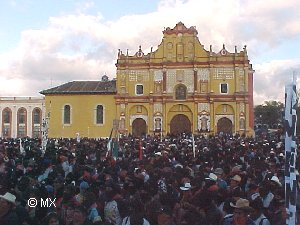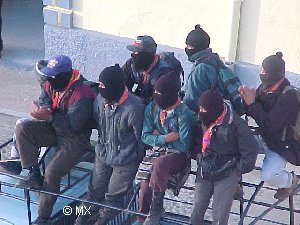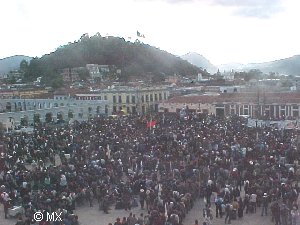archivos de los protestos globales
Thousands of Zapatistas participate in demo
January 14

Thousands of Zapatistas and Supporters Participate in Demo &Express Demands
by Andrew Kennis &Ryan Foster 4:10pm Sun Jan 14 '01

- In a story filed and reported directly from San Cristóbal de las Casas, Chiapas, Mexico, NYC-IMC reporter Andrew Kennis and Ryan Foster write on the general background of the Chiapas uprising and also write about how over 5,000 Zapatistas and supporters marched over a mile from the outskirts of San Cristóbal to the Plaza de la Paz to express Zapatista demands and solidarity.
- San Cristóbal, Chiapas, Mexico: On January 1st, 1994, the Zapatista Army of National Liberation (EZLN) undertook an uprising that would result in the occupation of over four towns in the Mexican state of Chiapas. The date of the uprising was symbolic, as it coincided with the official date for NAFTA implementation and as their spokesman Subcommandante Marcos explained, the "free-trade" pact was a "death sentence for the indigenous peoples." The uprising lasted for twelve days, when President Salinas declared a unilateral cease fire on January 12th. Thereafter, peace negotations began in February and a temporary settlement would wind up being rejected by the Zapatista communities (the communities are seen as the main base for decision making, as opposed to prior armed Latin American movements, which tended to depend upon a more hierarchal model). Eventually, a pact was agreed to on February 16, 1996 by both the government and the Zapatistas in the town of San Andrés (i.e. the San Andrés accords), but it was never implemented.
In the seven years that has passed since the uprising, a massive military occupation has ensued, resulting in denunciations from a plethora of respected human rights organizations, including Amnesty International. In their annual report from the past year, Amnesty reported that in Chiapas, "Human rights abuses, including killings, the torture and ill-treatment of detainees, and the displacement of indigenous communities" occurred alongside "Acts of intimidation directed at indigenous people by 'paramilitary'" groups. Such instances, Amnesty further notes, "were frequently reported." Global Exchange, a human rights group based in San Francisco with additional offices in Mexico City and San Cristóbal, reports that "the Mexican government first abandoned, and then undermined, efforts at a negotiated solution" and "instead, it relies on military and paramilitary forces to wage a campaign of low intensity warfare" that features "attacks by government supported paramilitary groups."
In the same report, Global Exchange reveals U.S. support and complicity, as "US-trained personal and US equipment are used in carrying out attacks on indigenous communities." Such support has occurred "Since 1997," whereby "the US has provided $1.12 billion dollars in military assistance to Mexico. In 1998, Mexico sent more military personal to the US for training than any country in the Western Hemisphere; in 1999, Mexico was second only to Colombia."
But after the long standing rule of the Instutional Revoluationary Party (PRI) was brought to an end in the Presidential election this past year (as well as in many regional and local elections), the newly elected President Fox of the National Action Party (PAN) had quipped that he could "solve the Chiapas problem in 15 minutes." That has not quite happened yet, and as a result, a demonstration was planned today in San Cristóbal de las Casas, to commemorate what had happened seven years ago and also to iterate current Zapatista demands.
The massive demonstration was perhaps not as monumental of an occassion as what happened seven years ago - but it came pretty close, as over 5,000 Zapatistas and supporters marched over a mile from the outskirts of San Cristóbal. The demonstrators first gathered early in the morning at around 9:30am, whereby journalists and onlookers had expected an early march. In true Zapatista form though, the march began unexpectedly late, as more and more Zapatistas and supporters kept filing in at the intersection of B. Juan Sabines &Periferico Sur (at around 2:00pm, for example, five bus loads of demonstrators arrived). Dozens and dozens of signs were displayed during this waiting period, as thousands of demonstrators sat in silence with their signs of protest loudly proclaiming their demands. Not a word or a chant was even breathed until the march finally began at around 3:00pm.
At that time, the previously silent group began a loud and highly emotionally charged march heading towards the Plaza de la Paz. At various points in the march, demonstrators ran and fervently chanted a number of Zapatista demands from the newly elected Mexican Presidential administration of Vicente Fox. In addition to the chants, many signs reflected the "three signals" necessary for the start of peace negotiations. The signals were stated by Marcos in a recent communique that was published in La Jornada: "the liberation of all Zapatista prisoners, the exit of the army from the seven positions and the constitutional recognition of indigenous rights and culture." The "seven positions" that Marcos mentioned refers to the seven military bases in Chiapas, which are now down to four, thanks to the closure of three bases by Fox in response to pressure from the Zapatistas and international supporters. Nevertheless, signs and chants demanded the immediate withdrawal and closure of the remaining four miiltary bases in Chiapas. In response to such demands, Fox was quoted in La Jornada as saying " ¿Que quiéren mas?" ("What more do they want?").
Other signs and chants seemingly answered Fox's question, as many more demands were articulated, such as a call for the complete release of all remaining Zapatista political prisoners and a demand for the immediate implementation of the San Andre's accords, currently waiting for approval from the Mexican legislature. During the speeches that were made in the Plaza following the march, another demand was articulated - a demand for democracy. The speakers defined democracy as meaning autonomy for the indigenous peoples of Chiapas, including native sovereignty rights over land use (the infamous slogan, "Tierra y Libertad" was repeated on more than one occassion).
The demonstrators themselves featured a wide array of people and supporters. Most prominently represented were the Zapatistas themselves, and their respective indigenous sympathizers. Even amongst this group, however, many types of clothing were worn and different chants were shouted. Ranging from "Long live the students of UNAM" to "Long live the army of the poor," the demonstrators' chants showed what has become typical for Zapatistas and their supporters - a significant level of solidarity with movements all around the world. Perhaps the most significant previous example besides today's show of support for other movements, was the important role that the Zapatistas played in organizing the formation of the Peoplés Global Action against Free Trade and the World Trade Organization (via several "encuentros") - the organization that went on to form the basis of organizing the protests that later shut down the WTO and caused the organization to be relatively impotent thereafter.
The demonstration comes in light of a highly anticipated trip by the EZLN Indigenous Revolutionary Clandestine Committee and an international delegation of supporters to Mexico City for peace negotiations with President Fox. The trip is due to start on February 26th and will culminate in the much hyped meeting with the President. A pre-condition for the talks set by the Zapatistas, however, included the three "signals," which were largely amplified during the demonstration, as noted above.
Two images that remained after the demonstration came from both the beginning and the end of the day's event. The first of which, was when a young Mexican girl delivered some food to a young indigenous girl - who hesitantly, but graciously accepted the show of support. At the end of the speeches in the Plaza, it was hard not to be struck by the impressive solidarity that the indigenous Zapatistas and their supporters gave to each other, as shown by the orderly and dignified way they filed out into the trucks and vans that would take them back to their respective autonomous communities.
bari.iww.org/~iww-nyc/CUNY
